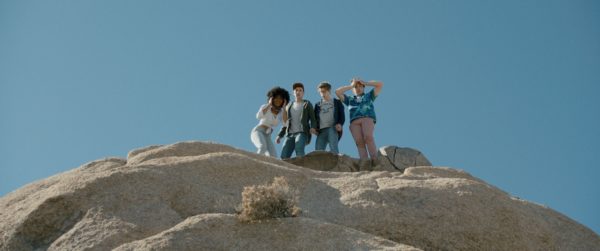
Head Count takes a fairly simple premise and manages to elevate it into something far greater than its limited production budget would seemingly allow. [Read more…]
The curated portfolio of film journalist Joe Lipsett
by Joe Lipsett

Head Count takes a fairly simple premise and manages to elevate it into something far greater than its limited production budget would seemingly allow. [Read more…]
by Joe Lipsett
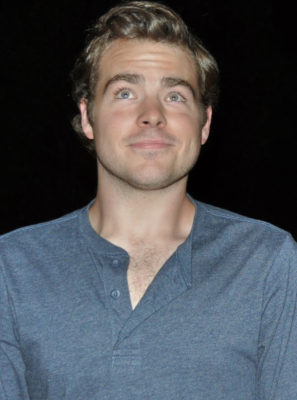 Name: Chris Moore
Name: Chris Moore
Age: 29
Birth Place: Jackson, MS
Sexuality: Gay
Notable films: Blessed Are the Children (2016), Triggered (2017), A Stranger Among the Living
When did you know you were queer? When did you come out?
Chris Moore: I came out in college to my close friends first. Thankfully, it was an art school, so being gay wasn’t much of an issue at all. Hell, it was probably encouraged.
I’d known I was gay since I was about 10 years old. I had an awakening when I saw, of all things, The Rage: Carrie 2 and fell madly in love with some of the guys in that. Looking back, there were signs before that. I remember noticing an older student on the playground when I was about 6 and just thinking that I needed to go hang out with him because he had beautiful eyes.
I was worried about everything living in the Bible Belt, so I kept it to myself for years and years. It wasn’t until after college that I started coming out to my family who were pretty supportive. I was a late bloomer, though. I didn’t even have a first kiss or sexual encounter until I was 24 or 25 which, in gay years, is about 52.
How did you get into filmmaking?
CM: I started when I was about 10 by using my family’s VHS-C camcorder and making a Scream fan film called Killer. I’d get my school friends to come over and we’d take turns playing Ghostface and Victim. My Mom would operate the camera and the boom box off to the side, so that we could have music in the scene, as well.
This was well before the days of easy and affordable digital home editing, so you had to use whatever you could. It was a mess, but that’s how the filmmaking bug bit me and I haven’t stopped since.
Why do you make horror films?
CM: Oh, boy! That’s a tough one. I think I make them to exorcise demons and confront my fears. I talk about things that scare me like bigotry, religious fanatics, depression, hate, losing one’s mind, etc. It’s an easier way to confront tough issues without making it feel heavy handed or too dour. If someone were to make a heavy drama about a single mother’s depression, not many people would be that interested because it sounds like a bit of a drag. Dress that depression up as a monster, however, and you have The Babadook.
Plus, horror films are an exercise in pure empathy (if you do them right). We’re forced into the shoes of someone who’s having the single worst day of their life!
I was a huge scaredy cat until I was about 6 or so. If you even walked me into the horror section of a video store or a really elaborate haunted house around Halloween, I’d freak out. I remember having the worst nightmares, too – worse than anything I’ve ever seen in a horror film. It wasn’t until my Dad showed me the original House of Wax with Vincent Price that I kinda sobered up and realized that horror could be a fun way to confront your fears.
Around that same time, my family went on vacation to Universal Studios and there was a Hitchcock attraction where they showed you how some of his biggest set pieces were achieved, including the shower scene from Psycho. Well, I thought this was the coolest thing ever and, the moment we got back, I just had to see Psycho in full. My Grammie had a copy and showed it to me and a love affair began. Pretty soon, I was trying to see any horror film I could and my nightmares disappeared.
These days, I’m much more frightened of reality than I am of any horror film or nightmare.
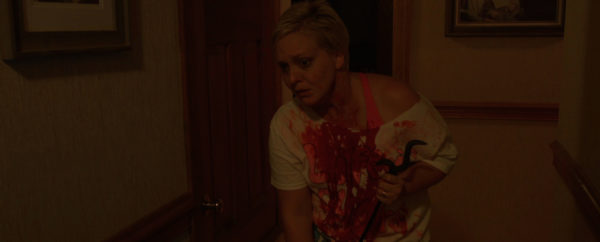
Blessed Are The Children
Your films are packed to the gills with homages to famous horror films so you obviously wear your influences on your sleeve. What films (queer or not) have made a significant impact on you and your work? In what way?
CM: Psycho is probably the most significant one, but Halloween had a huge impact in my early years. Carrie and A Nightmare on Elm Street were big ones as well. I think those are simply perfect films.
I’m drawn to all sorts of films, but I’d say stuff like Dressed To Kill, He Knows You’re Alone, Carnival of Souls, House on Haunted Hill, Scream, Suspiria, Deep Red, Martyrs, The Redeemer, Black Christmas, Inside, Alice Sweet Alice, The Sentinel, The Stepford Wives, Rosemary’s Baby, Creepshow, Poltergeist, Night of the Creeps, Prom Night, Let’s Scare Jessica To Death, Hell Night, Killer Party, Silent Scream, American Gothic, Night School, Butcher Baker Nightmare Maker, etc.
I don’t even know that I could explain why these films have stuck with me and inspired me, but they have. I love some of them because they’re legitimately scary and I love others because they’re just off the wall and fun. I like a nice mix. As long as they make me feel something, I’m happy.
How progressive or welcoming is the industry for queer creators right now?
CM: I’ve been fortunate not to have experienced much negativity due to my sexuality. Most of the critiques that I’ve gotten have been thoughtful and helpful and haven’t mentioned anything negative about the gay themes that might be baked into my work. Every now and then, you’ll get some looney who tries to poke fun at your work because of that stuff or because the film isn’t what they had expected (there’s always that one guy who laments the lack of topless actresses in my films), but the majority have been very open minded and lovely.
Then again, I’m doing this on a fairly small scale and most people don’t have any idea who the Hell I am, so that might help. If I were trying to get big studio movies made, I might be singing a different tune, but the indie world is a bit more freeing.
Both of your last few films have explicitly “out” characters (Mandy in Blessed are the Children and Ian in Triggered). Why is it important for you to have lead queer characters in your work?
CM: Visibility is so important. And various representations of LGBTQ characters are even better. For years, when you’d see a character like that on screen, they’d simply be the effeminate comic relief or the intense butch lesbian or the scary serial killer trans person.
I feel like people need a bigger variety of LGBTQ characters on screen these days. As a gay person myself, I crave stuff like that. Have you ever looked in the LGBTQ section of a video store or Amazon/Netflix? A lot of those movies aren’t very good. They’re telling the same dull coming out stories over and over again or the usual “I’ve fallen in love with a married ‘straight’ man” sagas. I think it’s time to put LGBTQ characters into different kinds of stories and roles because we’re more than our sexuality or gender expression.
I’ve always felt that one of the best LGBTQ characters of all time was in John Carpenter’s Someone’s Watching Me. Adrienne Barbeau plays a lesbian and it’s mentioned once or twice and then never brought up again. She’s allowed to exist as more than just a diversity quotient in the film. She feels like a real person and not a cliché. And this was a TV movie in the 70’s. I’m sure there are people in the community who want us to be loud and proud and not be portrayed as “normal,” but I like it when a character’s sexuality or gender is just a trait and it doesn’t really make a big difference in the story. It puts everyone on a more even playing field.
Do you subscribe to queer readings of your films?
CM: I support them 100%. I think it’s fabulous. I wonder if my films are even gayer than I had initially intended. They’re already pretty gay.
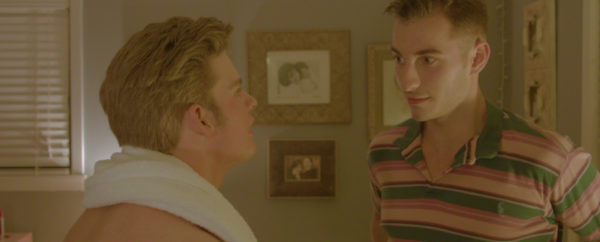
Triggered
You’ve spent a lot of time touring the festival circuit with your last two films. Have you had a chance to interact with many queer horror fans? What has that experience been like?
CM: I have and I have to say that they are some of the kindest, most passionate, and funniest human beings on this earth. I really don’t think there’s anything better than a queer horror fan. I feel like a lot of regular “bro” horror fans are just like “where are the tits? Where’s the blood? This ain’t no horror movie without those” whereas the queer horror fans are always more thoughtful and interested in story and characters. They love their gore and nudity, too, but they know that there’s more to horror film than just that.
I think that’s why so many of us worship at the altars of Heather Langenkamp, Jamie Lee Curtis, Amy Steel, Adrienne King, and Barbara Crampton, etc. They played these great characters who represent strength and survival and a lot of us have looked to them for inspiration over the years. I think that’s why, as a whole, queer horror fans tend to be more loving and accepting. We’ve had to fight to survive just like our favorite Final Girls.
I know you’re touring the circuit right now with your latest feature, Triggered and you’re currently in production on your next film. What more can you tell us?
CM: I’m super excited about it. It’s called A Stranger Among the Living and it’s close in tone to films like Let’s Scare Jessica To Death and Carnival of Souls. It’s a pretty big departure for me as both Blessed and Triggered had slasher elements and this one is much more of a creepy, dreamlike mood piece. It’s about a teacher who avoids a school shooting and starts being haunted by all sorts of creepy stuff. And yes, there’s a gay character (two actually!) We’re headed into post-production with that right now, so hopefully it’ll get around to some festivals by later this year or early next.
Follow Chris’ films on twitter:
by Joe Lipsett
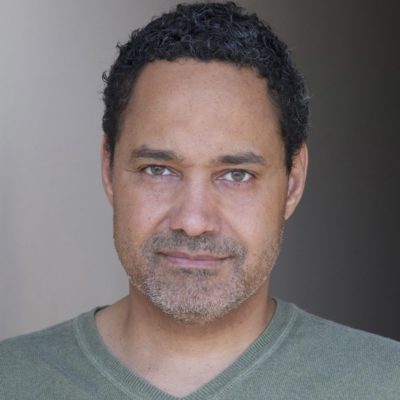 Name: Jeffrey Reddick
Name: Jeffrey Reddick
Age: (Bitch…who asks that? 🙂 49)
Birth Place: Florida, but I grew up in Kentucky and claim that as home
Sexuality: Gay
Notable films: Final Destination (2000), Tamara (2005), Day of the Dead (2008), Dead Awake (2016), The Final Wish (2018) and (soon) Good Samaritan
When did you know you were queer? When did you come out?
Jeffrey Reddick: I’ve known from as far back as I can remember. I didn’t know what to call it, but when I hit puberty, I realized that the feelings other men described about women was what I felt for men. It was interesting, because being bi-racial was also a big deal at the time. So I faced a lot of outward prejudice based on my race. My mom always went out of her way to tell me to love myself and not worry about what other people thought about me being “different.” That helped me deal with all of the homophobic stuff I heard growing up.
I came out to my best friend when I was 13. He said it was just phase, but was cool with it, so that was good. Other kids kind of assumed, but…and this is awful to say…they were so focused on my race that they bullied me for that rather than for being gay. And no girls’ parents would let them date me in high school, so I didn’t have to worry about the stress of pretending to like girls.
When I went to college and majored in theatre, it was a whole other world. It was very accepting. I was out in college and even started an LGBTQ group on campus.
I finally decided to come out to my mom in college. I think that’s one of the biggest burdens we carry if we’re not out to our families. No matter where we go in the world, there’s always the nagging feeling that if our families find out, they’ll stop loving us or disown us. Sadly, that still happens. My mom was an amazing mother, but she was also an older Southern woman and Southern people are really concerned about “what the neighbors think.” She wound up reacting in a typical fashion: she cried for a few days non-stop, but then her best friend literally told her to shut up and said ”he’s still the same son you raised.”
Once my mom realized it wasn’t a big deal to her best friend, I think it gave her permission to accept me. Again, this was in the late 80’s, so it was a much different time.
You’ve had an amazing and diverse career as a horror writer of both film and TV. What prompted the recent shift into directing and how did it come about?
JR: It was never my dream. I wanted to act in the early 90’s, but unless you could rap or wanted to play a thug or a pimp they didn’t know what to do with you (if you had dark skin). That’s why I transitioned to writing.
Directing was something I really became interested in, but, honestly, fear held me back for a long time. I have a few passion projects that I want to direct, but they’re big(ger) budget films. Most of my later scripts went the indie film route, which meant that I got to spend a lot of time on set and get comfortable.
With [feature directorial debut] Good Samaritan, it was a story that I wanted to tell and since we were doing it indie, and could get investors who were open to me directing, the opportunity was there, so I took it.
What is it about horror that attracts you?
JR: When I was younger it was definitely the “naughty” factor. My friends and I would watch the goriest films possible as an act of rebellion. After seeing the original Nightmare on Elm, I realized how amazing the genre could be and started reading Fangoria and became obsessed with it.
As a gay man, I do have a subconscious connection with the Final Girls of the 80’s. They were always good girls who didn’t fit in with the popular clique that was partying and have sex all the time. They were outsiders and they rose to be the victors, and that element really struck me. I love so many Final Girls and I think that also dovetails with a lot of gay men who love strong women. When I was growing up, Nancy Thompson was the ultimate to me. And Laurie Strode. And Amy Steel (the list is endless!)
I also started realizing how fun it was to scare people. Hearing people scream during a film you wrote is the ultimate thrill. It’s a genre that I’ve stubbornly stuck with and will probably do so for the rest of my career. I just find that you can tell so many types of stories and deal with topics in ways that you can’t in other genres. It’s just a world I love.
What films (queer or not) have made a significant impact on you and your work? In what way?
JR: A Nightmare On Elm Street is definitely the biggest influence. The complex heroine. The original, and terrifying, villain. The theme of the sins of the past haunting us resonates with me. I also love how Freddy would find people’s weaknesses and prey on them. That’s a theme in a lot of my films.
I also love all the standard classics like Halloween, Friday the 13th and films like that. Evil Dead scared the hell out me. And I love the beauty of films like Suspiria and the artistry and themes of Candyman. They all appeal to different aspects of me. When I write a slasher film, I try to think of kills that I haven’t seen before, but I love supernatural horror where you can bend the rules and mess with people’s head. I did realize with Good Samaritan that I’m more old school in my filming style; I don’t care for the hyper-edited, over-saturated look of films. I like movies that feel more grounded and real.
Topping the list of non-horror films that really impacted me was Maurice. It’s the first gay Merchant Ivory film. I stole money from my mom (bad me) and ordered it from The Oscar Wilde bookstore in New York. I watched that movie on a loop until the VHS tape wore out in my little trailer in Kentucky. Even though it’s a period piece, the story still resonates with many of the struggles that our community faces today. It deals with forbidden young love, religion, and conversion therapy, but it wasn’t a tragedy. It also spoiled men for me! I decided at 13 that one day I would marry a proper English chap. I still haven’t even visited London! (I need to get on that)
You’ve worked on so many diverse projects in different capacities. How progressive or welcoming is the industry (TV and film) for queer creators right now?
JR: It’s very welcoming. Hollywood is not free of homophobia by any means, but people forget that Hollywood isn’t a world unto itself. A lot of people here are artists who left their hometowns in the South and Midwest to follow their dreams and sometimes people bring their prejudices with them. Most people who vehemently dislike gay people have never actually met one, but there are plenty of gay people in Hollywood, so people change when they come here. It’s not magic in the air. It’s actually meeting normal people who happen to be gay and realizing that we’re regular people; we don’t have some nefarious agenda. We just want to live their lives.
The biggest problem isn’t with the behind the scenes stuff. It’s that Hollywood is very risk-averse, so they create content that will appeal to the vast majority of America and worry that “Middle America” isn’t ready for some stuff. That’s why it is much tougher being an out actor in Hollywood. Even if the studio heads don’t say publicly, they’re still averse to casting gay actors in traditional “straight” roles. I’ve seen it happen so much. And, of course, there are still actors who will sign on to a project and then not want to kiss a guy. I’ve seen several gay characters who were “de-gayed” for actors. Or gay content that watered down – Tamara being one example – to the point that it undermined what I was trying to say. So Hollywood is welcoming, but because making movies is such a risk, some people still want to play is safe when it comes to big studios films.
On the bright side, TV is thriving with its representation of LGBTQ characters. It’s astounding and really has given gay youth growing up today the kind of complex role models that I never had growing up. I always think it’s important for people to realize how fortunate we are to be living in the times we live in. Yes, we have forces trying to deny us our rights, but when I was growing up, there weren’t really any out gay actors to relate to. Living in Kentucky, I would find out an actor was gay after they died of AIDS. So it was sad and tragic and even when you tried to find some kinship with people like Rock Hudson, you realized they lived their lives in hiding. But then you would discover people like Clive Barker, who’s a brilliant talent, who was gay and open and you’d find these little rays of hope and inspiration.
But I think TV is really where the biggest and most impactful change has happened. We’ve gotta give Shonda Rhimes a huge shout-out for that. There are also a lot of gay celebrities who have done so much for the community: Ellen. Rosie. Neil Patrick Harris (just to name a few). They were all trailblazers. And Greg Berlanti has done such an amazing job of including gay and trans characters in so many of his shows. I think we’re really in the Golden Age of TV.
Do you believe that your sexuality informs your work?
JR: It can’t help but influence it. I think each of us has a distinct perspective and world view. You can give five writers the same concept and their stories will undoubtedly be different because they’re writing from a different place because of their experiences. I think the biggest way my sexuality influences me is that I understand the outsider who’s just trying to make a difference in the world (even if that difference is just to entertain someone for a few hours). Therefore my horror writing is more about fun scares and kills – not torture (although I do watch those films, as well).
For my scripts, I’ve always made sure to write strong women. They can be extremely sexy…but I don’t sexualize or fetishize them in the way that a straight writer might. And, of course, Final Destination had a “Final Boy” in Alex because I wanted to subvert the genre a little.
I’m also mindful to include gay characters in my work whenever possible…even though a lot of them have been changed. My friend Paul Etheredge wrote a gay slasher film called Hellbent about 20 years ago. I don’t think the world was ready for it, but it is now. Even though there wasn’t room for it in Good Samaritan, I do plan to be more involved going forward when my scripts are adapted. For me personally, I try to write gay characters where it’s not their defining characteristic. We are all so much more than our sexuality, even though society often tries to boil us down and act like that’s all we are.
Have you interacted with many queer horror fans of your work? What has that experience been like?
JR: A ton. There is such a large LGBTQ horror fanbase out there and it’s really a shame that no one has tapped into it. I meet so many fans and most of them are just excited to know that an out gay man created a franchise they love. I’ve gotten a lot of love for Tamara as well, even though the lesbian lead had that stripped from her and the “gay scene” in the film isn’t how I wrote it. But queer fans really relate to the story of an outsider who gets empowered and takes revenge her tormentors. It’s so much fun going to conventions and seeing younger people inspired to write/act/direct horror. Or couples who met on a Final Destination date and are still together. LGBTQ fans have this idea that the horror community isn’t accepting of gay people, but honestly I’ve found them to be the most welcoming group.
I love interacting with fans. In films, writers don’t get much attention, it’s all about the actors and directors. But horror fans are the greatest, most passionate and loyal fans. They’ve supported me through some great films (and some not so great ones) and they get excited about everyone – from cast to crew – involved in the horror films they love.
I’ve had some fans who say I inspired them to come out and that’s the most rewarding thing. Well, the most truly touching and rewarding thing is I’ve met a few fans who were closeted and depressed and said they contemplated suicide until they read an article or heard a podcast where I talked about being gay. It’s less about me; it’s about the importance of visibility. Let people know that you can be who you are, live your life without shame and go after your dreams. That’s why I have so much admiration for the people who have come before me.
So you’ve literally just announced your directorial debut, Good Samaritan. What can you tell me about the film? How is the transition to the director’s chair?
JR: I can tell you that it’s about a group of people who witness a man getting beaten and don’t help. When they start being killed off, our lead, Caitlin Kramer, is convinced that it’s a supernatural killer, but the police and everyone else thinks it’s a person making them pay for their crimes.
I hate to say this because I hate when other people make a horror film and then try to say it’s a supernatural thriller (as though horror is a dirty word)…but this movie is a supernatural mystery. Because the film plays with that uncertainty about whether there is a force after these people or if it is just a person, I couldn’t dig in to my bag of supernatural horror tricks or my slasher tricks. As a result, the kills aren’t shown, but the bloody aftermath is.
It was a great experience. It’s my first film, so even though I’ve been on a ton of movie sets, you really don’t know what you don’t know until you actually make a movie. It really is a miracle to get a film made and you have to be creative and flexible while shooting. We’re in post now, which is where the movie comes to life, so it’s really exciting. Directing is something that I definitely want to do again.
Follow Jeffrey on social media:
by Joe Lipsett
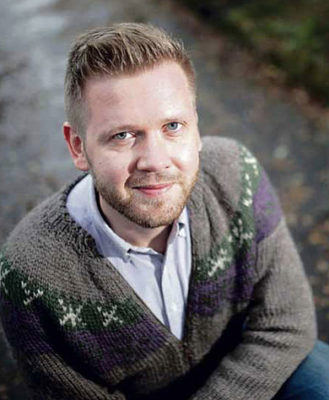 Name: Erlingur Thoroddsen
Name: Erlingur Thoroddsen
Age: 35
Birthplace: Reykjavik, Iceland
Sexuality: Gay
Notable films:Child Eater (2016), Rift (2017)
When did you know you were queer? When did you come out?
Erlingur Thoroddsen: I was about 12 when I realized that I liked boys more than I liked girls, but looking back there were definitely moments earlier in my life when it should have been obvious. But at the same time, most kids don’t really think about their sexuality until they reach puberty, so it makes sense that that’s the age when this realization happens.
I was 17 when I came out, and it was a long drawn-out process. I would tell a couple of friends and then wait a few weeks and tell some other friends. This went on for a year or so until I told my parents. Everyone was amazing and supportive — afterwards my family would walk with me in the Reykjavik Pride parade, and they still go every year even if I’m not around.
Iceland is very progressive and open-minded in general, so there was really no reason for me to be afraid of coming out, but at the same time I would always imagine the worst case scenarios. I guess that is the price you pay for having an hyperactive imagination.
How did you get into filmmaking?
ET: I was always fascinated with movies from a very early age. As a kid, I would much rather stay inside and watch TV than go outside and play. At a certain point I realized that there are actually people who make the movies and from there on, there was no stopping me. Initially, I wanted to be an actor because young me thought that the actors made the movies themselves (I was admittedly kind of a terrible actor).
Once I learned about the concept of writers and directors, everything changed. I must have been about ten years old when I started shooting home-made horror movies on my dad’s old mini-VHS camera. Over the years, those little shorts kept getting bigger and more ambitious, and in my twenties I decided to spend all my savings on going to film school in America – having grown up on American films, that seemed to make the most sense. I got accepted in the Columbia University film program and haven’t really looked back since!

Rift (2017)
Why do you make horror films?
ET: Horror is also something I gravitated towards very early. I think it was a mix of being tempted by the unknown and forbidden – and also a little masochistic appetite for fear. I was obsessed with horror VHS covers long before I was allowed to watch the movies, and I made my mom tell me the plots of the scary films she had seen. By hearing her plot descriptions and having seen key images from the VHS boxes, I was already making up movies in my head when I was very little.
The first two horror films I remember watching were Freddy’s Dead: The Final Nightmare (which got me obsessed with Freddy Krueger) and Aliens (which got me obsessed with that franchise), when I was seven years old. They both scared me to death. It was a feeling I kept wanting to come back to.
I think a part of the reason that I make horror films is a desire to replicate those emotions both for myself and for an audience. Horror also allows you to use interesting visual metaphors and explore societal themes without the burden of being “realistic” like a lot of other genres would require. In horror, everything goes, which is a very liberating thing creatively speaking.
What films (queer or not) have made a significant impact on you and your work? In what way?
ET: I could name so many, so I’ll stick with some of the highlights. I had a big Italian-horror movie obsession for years. For example, Dario Argento’s Suspiria and Profondo Rosso (Deep Red) made me realize how the camera can act as an active participant in telling the story, not bound to any of the characters necessarily. Brian De Palma is also a big influence for me, specifically his lurid thrillers like Dressed to Kill. I just love the passion and visual flare that’s on display. These are filmmakers that really deal in creating sensational moments that impact you viscerally and emotionally (maybe a little less emotionally in Argento’s case).
Some other horror titles that impacted me: Scream was like an encyclopedia of horror for me (it’s still one of my favorite films of all time). A Nightmare on Elm Street is the scariest film I’ve ever seen and Freddy Krueger will always be my #1 villain. The Innocents has perfect atmosphere and tension; it’s also one of the most beautiful films of all times. Vertigo is my favorite Hitchcock and really made me appreciate how mysteries with no easy solutions can make a movie stick with you forever (see also: Don’t Look Now, Mulholland Drive, Picnic at Hanging Rock). These are all films that about the journey, not the conclusion.
I’m leaving out so many things I love, but if it was directed by Verhoeven, Bergman, Spielberg, Tarkovsky or Carpenter, chances are that I stan.
(Also, Aliens because it is perfectly structured and probably the film I’ve seen the most.)
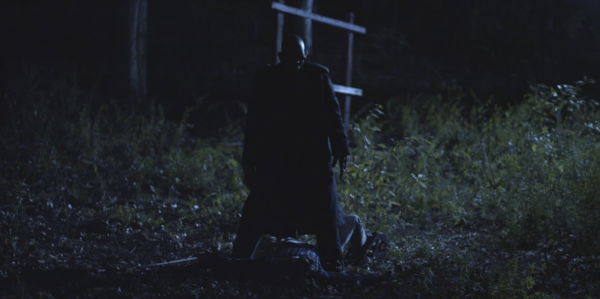
Child Eater (2016)
You’re an Icelandic filmmaker, so your experiences getting films off the ground may be completely different from other directors in this showcase. How progressive or welcoming do you think the industry is for queer creators right now?
ET: I can only speak from my own experiences as a white gay director, and from what I have heard anecdotally from others, but my sense is that there is definitely an industry-wide desire to make queer movies and TV. The problem is, I think a lot of studios don’t really know *what kind* of queer movies they want to make. I’ve heard from people who go in to pitch something that features gay protagonists and the feedback they get is that it’s “too gay” or that their ideas are somehow not relatable enough for a broad audience. Basically there’s a suggestion that there is a right kind of queer content and a wrong kind of queer content.
I think the studios are torn between wanting to be progressive and “with the times,” but not really knowing what that means. For a lot of them, the idea of “queer” seems to be very clean-cut and mainstream.
They are thinking about what will sell and that’s a hard thing to figure out because there’s not a lot of studio-level examples they can look at (although, this seems to be changing a lot more rapidly in TV). Most overtly queer horror films are made in the indie or foreign space. The horror community rallies around those films but in terms of financial success, they might not be the examples to inspire confidence in studio execs. So it’s this Catch 22 situation where there’s a desire to do something, but also a lot of fear about it at the same time.
Rift feels like a very personal film. How informed by your own experiences was the narrative of that film? Does your sexuality play a part in your filmmaking practice normally?
ET: It was very much informed by my own experiences. When I started writing it, I had just gone through a breakup and was stuck in a prolonged “dark night of the soul” period. I had a lot of stuff on my mind: about how loving someone doesn’t mean you should be with them; co-dependency; how two people who share a moment might have very different memories of that moment. Stuff like that.
At the same time I felt frustrated that I didn’t have a second feature in the pipeline, so I decided I would just make something on my own. I figured I could do a film inexpensively if I had two actors in one cabin and it made sense to take all the things I had on my mind and have those characters explore them. Writing the script was basically a long therapy session for me.
Overall, I think my sexuality definitely plays a part in my creative process. It’s a big part of who I am and the community I spend the most time with, so I think it is only normal that it finds its way into my work. Sometimes it happens in overt ways, and sometimes it’s more subtextual. I try not to question my creative impulses too much. Once I have good idea, I like to run with it and see where it takes me. I feel like most of the stuff I write or come up with has a queer component in one way or another, but I also don’t like to force anything into a story if it doesn’t feel right. It all depends on the project.
That said, I generally feel that a queer element makes what I’m watching at least 20% more interesting.
Do you subscribe to queer readings of your films?
ET: Absolutely! Before film, my background was in comparative literature, so basically I will subscribe to any reading of my films as long as the text warrants it and/or the critic makes a compelling argument.
And it’s kind of easy for my films. I’ve made two features so far, one of which is all about a disintegrated gay relationship and the other one is about an imaginative little boy who is terrorized by a monster in his closet…
Wonder where that comes from…
Have you interacted with many queer horror fans of your films? What has that experience been like?
ET:A little bit, yeah. I was fortunate enough to get to travel around the world with Rift when it did the festival circuit and I met a lot of people who were really taken by the movie. I think its themes are universal and people who have gone through hard breakups really relate to it, queer or not – although I do think there is something in that film that specifically speaks to gay men. I’ve also seen a lot of love online, as well as deep-dives and close readings into the film that have impressed me quite a bit.
It’s really rewarding and humbling for me that people want to talk about the film at all, let alone with so much passion. I love it.
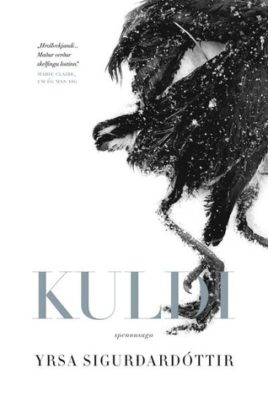
Kuldi (Cold)
I’m both excited and nervous about word of an American remake of Rift. How involved will you be on that? And what else do you have on your plate?
ET: There is no need to be nervous! I am definitely involved and have been developing a script for the new version with Orion Pictures, which has been an amazing experience. It’s a story that is too close to my heart for me to give it up completely to someone else.
I can’t say too much about it at the moment other than it is still going to be very queer and scary — probably even scarier! I really couldn’t be more excited about where we are taking it.
Everyone involved is a big fan of the original film so I feel like I’m in great hands. I can’t wait to give you more info, but I have to keep tight-lipped for now!
Otherwise, I’ve got a few other things on my plate, one of which is an adaptation of a fantastic Icelandic bestseller called Cold (Kuldi in Icelandic). It’s a mystery thriller with some spooky elements and some mind blowing twists. It’s really fun and will let me explore some of my Hitchcock/De Palma fetishes a bit more. The idea is to shoot it this coming winter, so that and Rift are keeping me plenty busy at the moment.
Follow Erlingur on social media:
by Joe Lipsett
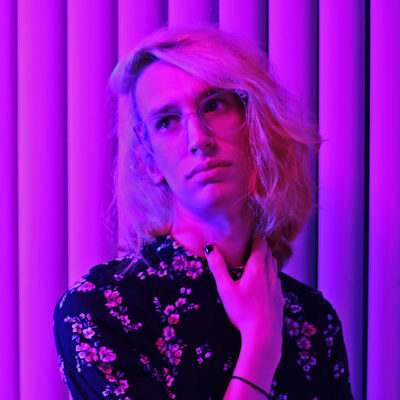 Name: DRW Phillips
Name: DRW Phillips
Age: 23
Birth Place: Indianapolis, IN
Sexuality: Pansexual
Notable films: Posters Lazarus, Bliss, Long Lost
When did you know you were queer? When did you come out?
DRW: I knew that I was trans from as far back as elementary school, but it was also something that I repressed for years. In the eighth grade I knew that I was, at the very least, bisexual (shout out to Europe’s “Final Countdown” video for helping me get there) and I attempted to come out as bi to one of my closest friends. It backfired and my entire friend group turned into my tormentors. I dove back into the closet through high school and wasn’t able to come out and explore my sexuality until college.
It wasn’t until the unending terror of the 2016 election that I finally came out as transgender. I was no longer in a place where I was willing to be intimidated anymore.
You’ve made quite a name for yourself making “alt” posters for famous films. How did that begin?
DRW: I did a lot of loose design in high school and college, little things for the music scene or classmates’ films. At the end of 2017 I decided that this was something I wanted to pursue seriously and planned an entire year of doing one poster design for a film a day. I’d been really taken by artists like Scott Saslow who had done similar projects before and loved the variety a project like this demanded.
I did over 365 posters on my Instagram account in 2018 and have been fortunate enough to begin to turn that into a full time career as a designer. Since then I still make room for self initiated pieces in between my official projects to keep trying new styles and adding more tools to my belt.
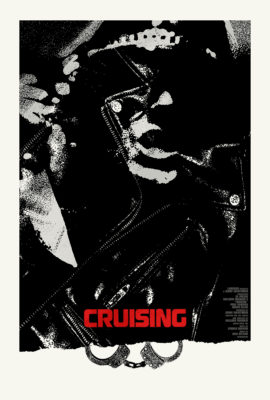
DRW’s alt poster for Cruising
You have created posters for all different kinds of films, but you seem most prolific in the horror genre. What attracts you to those projects?
DRW: I’m a big cinephile, but my biggest love will always be for horror films. It’s one of the most potent genres in the world that allows filmmakers and artists alike to take creative leaps that wouldn’t be allowed anywhere else. Exploring films like The Fog, Manhunter, The Devils, and even Zulawski’s Possession allowed me to be as creative and experimental as possible in a way that would still properly serve the films I was paying homage to.
A majority of the artists that I look up to are those that operate within the horror and genre space. Jay Shaw, Graham Humphreys, Stephen Sayadian, Chris Garofalo, and others have all made indelible marks on myself and horror fans around the world through their art. On top of that, the horror community is one of the strongest and most supportive in the world.
As a producer on the queer horror podcast Dead for Filth, I became connected to that community and have seen first hand how spectacular and unique it is. People are so excited to share their love for these movies in a way no other genre or fandom can replicate. It’s always an honor for me to be asked to contribute to a horror film.
 What films (queer or not) have made a significant impact on you and your work? In what way?
What films (queer or not) have made a significant impact on you and your work? In what way?
DRW: Luis Buñuel’s The Phantom of Liberty changed my life. It’s a surrealist comedy from 1974. It has no plot but it’s highly subversive and strange. The poster by my favorite artist in the world, René Ferracci, is outrageous and iconic. It’s a simple collage of a bright pink butt dressed as the Statue of Liberty with a wilting torch and standing on ostrich legs. It was used on the VHS and DVD and it just hit me like a ton of bricks the first time I saw it casually sitting on a shelf at the library. The movie and the poster together were like a 1-2 punch that completely threw me off my axis and set me on a new path. I now have that original poster framed above the desk where I work.
How progressive or welcoming is the industry for queer creators right now?
DRW: I’ve been rather fortunate within the horror and design communities to have found a great deal of acceptance. Most everyone I know within the horror space identifies within the LGBTQ spectrum in one way or another. The world of design is still predominantly white and male, but what matters most is the work and less who is behind it.
Along with the democratization of digital design tools, the space has started to open up to more diverse voices. We still have a long way to go in the entertainment industry as a whole, though, particularly for trans voices and creators.
That shouldn’t dismay anyone from wanting to step into the space, though. The only way we’ll be able to become as progressive and open as we need is to have as many people from different backgrounds and identities join and change the industry from within. The only people who can speak for us are ourselves.
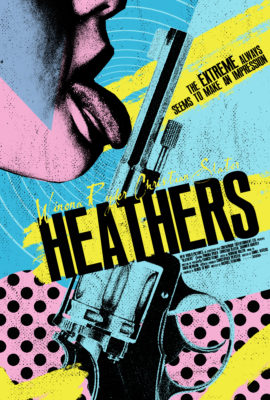
DRW’s alt poster for Heathers
Do you believe that your sexuality informs your work?
DRW: I do believe that my work is informed by my trans and queer identity. Creating any kind of art is an expression of a point of view. When I create a design, whether as a personal or commissioned project, it’ll always be simply an interpretation of a film or an album through my inherently queer, trans perspective. That’s something that cannot be separated from the work – just as it can’t be separated from who I am as a person or as an artist.
Do you subscribe to queer readings of your films?
DRW: I’m a big advocate of finding queer readings within traditionally “non-queer” media. There are simply too few stories out there detailing our perspective and identities that we still have to search for coded characters and narratives to fulfill our natural need to see ourselves affirmed within media.
As someone who identifies as a queer individual, I believe that everything I do is, in one way or another, queer and therefore a slightly transgressive act. It’s always a great compliment if others see that as well.
Have you interacted with many queer horror fans of your films? What has that experience been like?
DRW: Queer horror fans are the best people in the world. I am gobsmacked whenever I see or meet anyone within the queer horror space that owns piece of my work.
Someone recently had the artwork that I did inspired by John Carpenter’s The Fog made into their shower curtain. I do not have to words to express how crazy and amazing that is. That is the main audience I am looking to please.
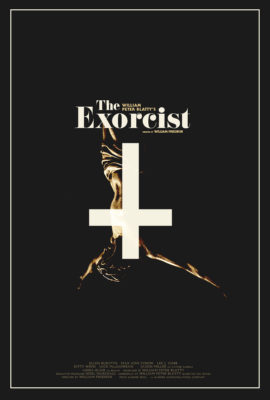
DRW’s alt poster for The Exorcist
What’s next for you?
DRW: I have a few more official posters and a limited edition blu-ray coming out later this year that I can’t wait to share with the world. I hope to be able to continue making strange and subversive designs for some time.
Follow DRW on social media:
by Joe Lipsett
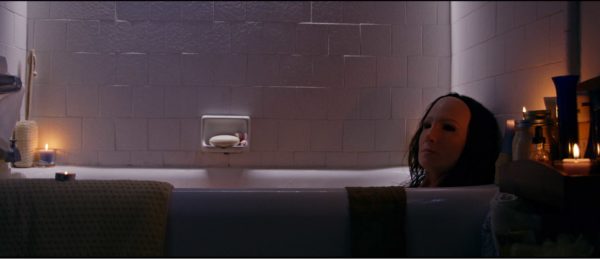
There’s an uncomfortable tension at work in The Cleaning Lady, Jon Knautz’s feature length adaptation of his short of the same name. It’s in the key art for the film (a woman wears a domestic maid’s uniform, bloody gloves and an uncanny-looking mask) and it’s baked into the premise, about the obsessive relationship that develops between Alice (Alexis Kendra, who also co-wrote the script), a successful, albeit flawed aesthetician and her disfigured cleaning woman, Shelly (Rachel Alig).
The Cleaning Lady is first and foremost a stalker film. Alice hires Shelly on the down low to privately clean her apartment, thereby allowing the meek, mysterious woman access to her home. Considering that the film opens with Shelly brewing a rat smoothie and feeding it to a chained woman in an abandoned shipping container, it’s immediately clear that Alice is making a mistake. And just in case it wasn’t obvious, Knautz includes a horror musical cue when Alice first stumbles upon Shelly cleaning her clogged shower drain.
Alice and Shelly are contrasted using straightforward visual cues: Alice is blonde and her apartment is bathed in a sunny yellow colour, whereas Shelly’s dark hair continually hangs in her face and her home is located off the beaten path in the woods. Alice is also pert and chipper, good at casual small talk and maintaining her physique with regular yoga classes. Shelly is barely verbal, going about her business quietly with her head down. It’s only when Alice hires and then befriends Shelly that the latter begins to open up; alas, it simultaneously initiates her unhealthy obsession with Alice’s seemingly perfect life.
The fact that Alice’s “perfection” is a facade isn’t evident to Shelly, who idolizes her new employer. The reality is that Alice is a slave to her vices, which range from small – her inability to quit smoking – to large – carrying on an affair with a married man, Michael (Stelio Savante). The discovery that Alice isn’t living up to Shelly’s expectations push the cleaning woman over the edge and, naturally, violence follows.
Artificiality as a “cover up” is an obvious, but effective metaphor for both Alice and Shelly. Alice only looks put together because she has the proper make-up, clothes and body, whereas Shelly’s refusal to play dress up for the world – opting for ball caps, no make-up and baggy clothes – immediately distinguish her as an outsider.
And therein lies the problem. Anything interesting that The Cleaning Lady has to say about living fake lives, dressing to pass, or using a make-over as cover-up (literally and figuratively) is undone by a script that favours exploitation and titillation over genuine human emotion.
Not unlike Blumhouse’s recent thriller Ma, The Cleaning Lady wants to explore how childhood trauma contributes to the development of adult victimizers. In this case, sporadic flashbacks introduce a young Shelly (Mykayla Sohn), a minor being sexually exploited by her mother, pimped out to random men in exchange for money. These glimpses into the past have the same sweaty, grimy sheen as the flashbacks in Black Xmas, and young Shelly’s infantile interest in dolls is nicely juxtaposed by the decrepitness of the rest of the house and the leering, greasy pedophiles. It’s all suitably icky.
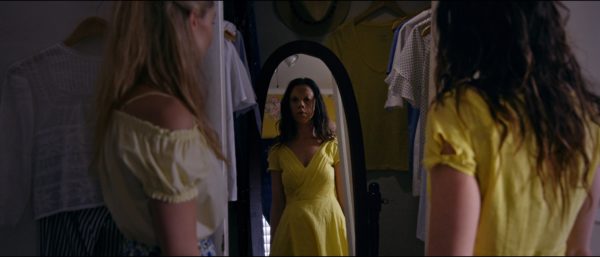
It’s also on-the-nose obvious; the flashbacks serve as a narrative shorthand to “explain” adult Shelly’s psychosis. But, while it is not uncommon in horror to assign a childhood trauma to villains, here it is both too fleeting and too simplistic. The Cleaning Lady lacks finesse, resulting in a series of clunky flashbacks that trade in manipulative exploitation and seemingly exist to pay-off the film’s obvious conclusion.
Despite the clumsy use of overly simplistic pop psychology to explain Shelly’s motivation, The Cleaning Lady does have a number of elements worth recommending. The performances by both lead actresses are solid and Knautz makes good use of a few key locations to maintain a claustrophobic feel as Shelly slowly collapses the boundaries between her and her prey. There are several set pieces that really connect, the creepiest of which is a late night sojourn by Shelly into Alice’s bedroom to make a latex mask of Alice’s “perfect” visage. It’s deeply unsettling, and makes for a fascinating mirroring effect when the prosthetic becomes Shelly’s trademark mask.
Speaking of make-up, the effects are a bit of a mixed bag: for every effect that works (Shelly’s burns), there’s another that doesn’t quite hit the mark (a torture scene involving acid is particularly unconvincing). This is forgivable, however, considering that budget undoubtedly played a factor.
Unfortunately the film is undone by its undercooked script. In addition to the explanation for Shelly’s mental state, there’s an abrupt narrative shift in the last act that derails the film’s focus by thrusting a heretofore peripheral character into the spotlight. It simply does not work and the poorly executed creative decision comes off as a cheap (and predictable) attempt to inject tension (and increase the body count), but actually just muddles the narrative at a time when it should be crescendoing. It’s an unfortunate development that negatively impacts the film’s ending and the film would have been better off ironing it out of the script early on.
The Bottom Line: The Cleaning Lady has strong lead performances, a creepy premise and a few unsettling set pieces, but it is undone by poor script decisions, particularly the cheap reliance on exploitative flashbacks. 2.5/5
https://www.youtube.com/watch?v=l92FHpCtysU